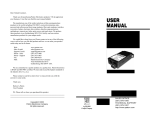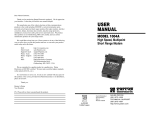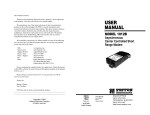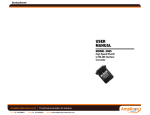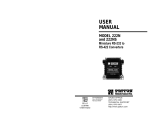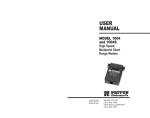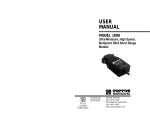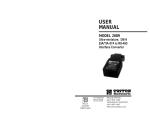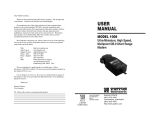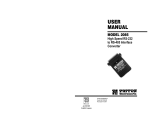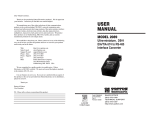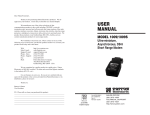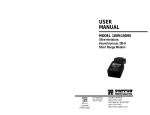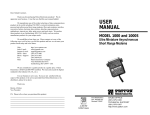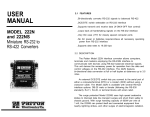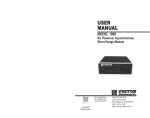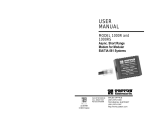Download USER MANUAL MODEL 1012A Asynchronous Carrier Controlled
Transcript
USER MANUAL MODEL 1012A Asynchronous Carrier Controlled Short Range Modem CERTIFIED Copyright © 1996 Patton Electronics Company All rights reserved. An ISO-9001 Certified Company Part# 07M1012A-B Doc# 040011U, Rev. C Revised 1/22/08 SALES OFFICE (301) 975-1000 TECHNICAL SUPPORT (301) 975-1007 http://www.patton.com 1.0 WARRANTY INFORMATION Patton Electronics warrants all Model 1012A components to be free from defects, and will—at our option—repair or replace the product should it fail within one year from the first date of shipment. This warranty is limited to defects in workmanship or materials, and does not cover customer damage, abuse or unauthorized modification. If this product fails or does not perform as warranted, your sole recourse shall be repair or replacement as described above. Under no condition shall Patton Electronics be liable for any damages incurred by the use of this product. These damages include, but are not limited to, the following: lost profits, lost savings and incidental or consequential damages arising from the use of or inability to use this product. Patton Electronics specifically disclaims all other warranties, expressed or implied, and the installation or use of this product shall be deemed an acceptance of these terms by the user. 1.1 RADIO AND TV INTERFERENCE The Model 1012A generates and uses radio frequency electromagnetic energy, and if not installed and used properly—that is, in strict accordance with the manufacturer's instructions—may cause interference to radio and television reception. The Model 1012A has been tested and found to comply with the limits for a Class A computing device in accordance with the specifications in Subpart J of Part 15 of FCC rules, which are designed to provide reasonable protection from such interference in a commercial installation. However, there is no guarantee that interference will not occur in a particular installation. If the Model 1012A does cause interference to radio or television reception, which can be determined by disconnecting the RS-232 interface, the user is encouraged to try to correct the interference by one or more of the following measures: moving the computing equipment away from the receiver, re-orienting the receiving antenna and/or plugging the receiving equipment into a different AC outlet (such that the computing equipment and receiver are on different branches). In the event the user detects intermittent or continuous product malfunction due to nearby high power transmitting radio frequency equipment, the user is strongly advised to take the following steps: use only data cables with an external outer shield bonded to a metal or metalized connector. 1.2 SERVICE All warranty and nonwarranty repairs must be returned freight prepaid and insured to Patton Electronics. All returns must have a Return Materials Authorization number on the outside of the shipping container. This number may be obtained from Patton Electronics Technical Support: (301) 975-1007; http://www.patton.com; or, 1 [email protected]. Notice: Packages received without an RMA number will not be accepted. Patton Electronics' technical staff is also available to answer any questions that might arise concerning the installation or use of your Patton Model 1012A. Technical Service hours: 8AM to 5PM EST, Monday through Friday. 2.0 GENERAL INFORMATION Thank you or buying the Patton Model 1012A. This product has been thoroughly inspected and tested and is warranted for One Year parts and labor. Contact Patton Electronics Technical Support if you have any questions. 2.1 FEATURES • • • • • • • • • Allows up to 10 terminals to use a single port Supports hardware handshaking Full or half duplex, point-to-point or multipoint External DCE/DTE switch Automatic equalization and gain control Transformer isolation No AC power required Supports data rates to 38,400 bps, distances to 6 miles Silicon Avalanche Diode surge protection • Twisted pair connection via RJ-11, RJ-45, terminal blocks with strain relief or dual modular jacks (for daisy chaining) • Made in the U.S.A 2.2 DESCRIPTION The Patton Model 1012A asynchronous short range modem was designed for point-to-point or multidrop applications requiring hardware handshaking. In a multipoint environment, the master transmits data simultaneously to up to 10 addressable terminals. The terminals contend for the main channel by activating RTS (pin 4). Automatic equalization and gain control ensure the accuracy of transmitted data. Built-in transformers eliminate much of the noise which can occur in commercial buildings. These transformers also eliminate ground loops caused by differences in reference ground. Consequently, the Model 1012A may be used to extend RS-232 distances in environments where connected equipment is located in different buildings. The 1012A uses the latest in bidirectional, clamping, transient suppressors to protect itself and any connected equipment against harmful transient surges. The 1012A can dissipate 600W per wire at 1.0 mS. Response times are typically 1.0 μS from 0 to the nominal breakdown level of 6.8 volts. 2 1.0 WARRANTY INFORMATION Patton Electronics warrants all Model 1012A components to be free from defects, and will—at our option—repair or replace the product should it fail within one year from the first date of shipment. This warranty is limited to defects in workmanship or materials, and does not cover customer damage, abuse or unauthorized modification. If this product fails or does not perform as warranted, your sole recourse shall be repair or replacement as described above. Under no condition shall Patton Electronics be liable for any damages incurred by the use of this product. These damages include, but are not limited to, the following: lost profits, lost savings and incidental or consequential damages arising from the use of or inability to use this product. Patton Electronics specifically disclaims all other warranties, expressed or implied, and the installation or use of this product shall be deemed an acceptance of these terms by the user. 1.1 RADIO AND TV INTERFERENCE The Model 1012A generates and uses radio frequency electromagnetic energy, and if not installed and used properly—that is, in strict accordance with the manufacturer's instructions—may cause interference to radio and television reception. The Model 1012A has been tested and found to comply with the limits for a Class A computing device in accordance with the specifications in Subpart J of Part 15 of FCC rules, which are designed to provide reasonable protection from such interference in a commercial installation. However, there is no guarantee that interference will not occur in a particular installation. If the Model 1012A does cause interference to radio or television reception, which can be determined by disconnecting the RS-232 interface, the user is encouraged to try to correct the interference by one or more of the following measures: moving the computing equipment away from the receiver, re-orienting the receiving antenna and/or plugging the receiving equipment into a different AC outlet (such that the computing equipment and receiver are on different branches). In the event the user detects intermittent or continuous product malfunction due to nearby high power transmitting radio frequency equipment, the user is strongly advised to take the following steps: use only data cables with an external outer shield bonded to a metal or metalized connector. 1.2 SERVICE All warranty and nonwarranty repairs must be returned freight prepaid and insured to Patton Electronics. All returns must have a Return Materials Authorization number on the outside of the shipping container. This number may be obtained from Patton Electronics Technical Support: (301) 975-1007; http://www.patton.com; or, 1 [email protected]. Notice: Packages received without an RMA number will not be accepted. Patton Electronics' technical staff is also available to answer any questions that might arise concerning the installation or use of your Patton Model 1012A. Technical Service hours: 8AM to 5PM EST, Monday through Friday. 2.0 GENERAL INFORMATION Thank you or buying the Patton Model 1012A. This product has been thoroughly inspected and tested and is warranted for One Year parts and labor. Contact Patton Electronics Technical Support if you have any questions. 2.1 FEATURES • • • • • • • • • Allows up to 10 terminals to use a single port Supports hardware handshaking Full or half duplex, point-to-point or multipoint External DCE/DTE switch Automatic equalization and gain control Transformer isolation No AC power required Supports data rates to 38,400 bps, distances to 6 miles Silicon Avalanche Diode surge protection • Twisted pair connection via RJ-11, RJ-45, terminal blocks with strain relief or dual modular jacks (for daisy chaining) • Made in the U.S.A 2.2 DESCRIPTION The Patton Model 1012A asynchronous short range modem was designed for point-to-point or multidrop applications requiring hardware handshaking. In a multipoint environment, the master transmits data simultaneously to up to 10 addressable terminals. The terminals contend for the main channel by activating RTS (pin 4). Automatic equalization and gain control ensure the accuracy of transmitted data. Built-in transformers eliminate much of the noise which can occur in commercial buildings. These transformers also eliminate ground loops caused by differences in reference ground. Consequently, the Model 1012A may be used to extend RS-232 distances in environments where connected equipment is located in different buildings. The 1012A uses the latest in bidirectional, clamping, transient suppressors to protect itself and any connected equipment against harmful transient surges. The 1012A can dissipate 600W per wire at 1.0 mS. Response times are typically 1.0 μS from 0 to the nominal breakdown level of 6.8 volts. 2 3.0 CONFIGURATION 3.2 SETTING THE RTS/DCD CONTROL STRAP The Model 1012A has one switch and one strap that must be set for the unit to function properly in its application. This section shows how to set both the DCE/DTE switch and the RTS/DCD strap. Figure 1 shows the location of the DCE/DTE switch and the RTS/DCD strap on the Model 1012A PC board. The RTS/DCD strap (see Figure 1) is located internally on the Model 1012A's PC board. To access this strap, use a small flat blade screwdriver to pop open the Model 1012A's case as shown in Figure 3. DCE/DTE Switch Surge Suppressors RTS/DCD Control Strap Terminal Block Isolation Transformers Figure 1. Model 1012A Board, Showing Switch and Strap Locations 3.1 SETTING THE DCE/DTE SWITCH For your convenience, the Model 1012A has an externally accessible DCE/DTE switch (see Figure 2). If the device connected to the Model 1012A is a PC, terminal or host computer (or is wired like one), set the switch to “DCE.” This causes the Model 1012A to behave like Data Communications Equipment and transmit data on pin 3. If the device connected to the Model 1012A is a modem or multiplexer (or is wired like one), set the switch to “DTE.” This setting causes the Model 1012A to behave like Data Terminal Equipment and transmit data on Pin 2. DCE DTE DTE Figure 2. Externally Accessible DCE/DTE Switch Figure 3. Using a Small Screwdriver to Open the Model 1012A Case The RTS/DCD control strap setting on the Model 1012A determines how its transmitter (i.e. carrier) is activated. When this strap is removed from the pegs, the 1012A transmitter is CONSTANTLY ON. When the strap is in place on the pegs, the transmitter is enabled by activating RTS (Pin 4 in DCE mode) or DCD (Pin 8 in DTE mode). Table 1 below summarizes the interaction between the DCE/DTE switch setting and the RTS/DCD strap setting. DCE/DTE Switch Setting DCE DTE RTS/DCD strap in place Carrier activated by RTS - pin 4 Carrier activated by DCD - pin 8 RTS/DCD strap removed Carrier constantly ON Carrier constantly ON Table 1. Interaction of DCE/DTE Switch and RTS/DCD Strap 3 4 3.0 CONFIGURATION 3.2 SETTING THE RTS/DCD CONTROL STRAP The Model 1012A has one switch and one strap that must be set for the unit to function properly in its application. This section shows how to set both the DCE/DTE switch and the RTS/DCD strap. Figure 1 shows the location of the DCE/DTE switch and the RTS/DCD strap on the Model 1012A PC board. The RTS/DCD strap (see Figure 1) is located internally on the Model 1012A's PC board. To access this strap, use a small flat blade screwdriver to pop open the Model 1012A's case as shown in Figure 3. DCE/DTE Switch Surge Suppressors RTS/DCD Control Strap Terminal Block Isolation Transformers Figure 1. Model 1012A Board, Showing Switch and Strap Locations 3.1 SETTING THE DCE/DTE SWITCH For your convenience, the Model 1012A has an externally accessible DCE/DTE switch (see Figure 2). If the device connected to the Model 1012A is a PC, terminal or host computer (or is wired like one), set the switch to “DCE.” This causes the Model 1012A to behave like Data Communications Equipment and transmit data on pin 3. If the device connected to the Model 1012A is a modem or multiplexer (or is wired like one), set the switch to “DTE.” This setting causes the Model 1012A to behave like Data Terminal Equipment and transmit data on Pin 2. DCE DTE DTE Figure 2. Externally Accessible DCE/DTE Switch Figure 3. Using a Small Screwdriver to Open the Model 1012A Case The RTS/DCD control strap setting on the Model 1012A determines how its transmitter (i.e. carrier) is activated. When this strap is removed from the pegs, the 1012A transmitter is CONSTANTLY ON. When the strap is in place on the pegs, the transmitter is enabled by activating RTS (Pin 4 in DCE mode) or DCD (Pin 8 in DTE mode). Table 1 below summarizes the interaction between the DCE/DTE switch setting and the RTS/DCD strap setting. DCE/DTE Switch Setting DCE DTE RTS/DCD strap in place Carrier activated by RTS - pin 4 Carrier activated by DCD - pin 8 RTS/DCD strap removed Carrier constantly ON Carrier constantly ON Table 1. Interaction of DCE/DTE Switch and RTS/DCD Strap 3 4 4.0 INSTALLATION The RTS/DCD control strap setting has no effect on how the carrier detect signal is output. However, the DCE/DTE setting does have an effect. If the DCE/DTE switch is set to “DCE,” the carrier detect is output on Pin 8. If the DCE/DTE switch is set to “DTE,” the carrier detect is output on Pin 4. Table 2 summarizes the interaction between the DCE/DTE switch setting and the receiver. Once you have properly configured the Model 1012A, you are ready to connect it to your system. This section tells you how to connect the Model 1012A to the twisted pair and RS-232 interfaces, and how to operate the Model 1012A. 4.1 HOW TO CONNECT TO THE TWISTED PAIR INTERFACE DCE/DTE Switch Setting DCE DTE All Receivers Carrier detect is output on pin 8 Carrier detect is output on pin 4 Table 2. Interaction of DCE/DTE Switch and RTS/DCD Strap Note: For multipoint applications, it is necessary to have a strap in place on the pegs and RTS control signal for slave units. The Model 1012A passes data and handshaking signals between two RS-232 devices at distances to 6 miles (1.8m) and data rates to 38.4 Kbps. There are two requirements for installing the Model 1012A. 1. These units work in pairs. Therefore, you must have one Model 1012A at each end of a two twisted pair interfaces. 2. To function properly, the Model 1012A needs two twisted pair of metallic wire. They must be unconditioned, dry metallic wire, between 19 and 26 AWG (the higher number gauges may limit distance somewhat). Standard dial-up telephone circuits, or leased circuits that run through signal equalization equipment, are not acceptable. 3.3 POST CONFIGURATION INSTRUCTIONS Once you have finished setting the Model 1012A's RTS/DCD strap, pause before you snap the case halves back together. If you are connecting the Model 1012A to twisted pair using the internal terminal blocks, go to Section 4.1.1 and continue the installation procedure. If you are connecting the Model 1012A to twisted pair using the RJ-11, RJ-45 jacks (single or dual), make sure all the pieces are properly set and then snap the case halves back together. For your convenience, the Model 1012A is available with five different twisted pair interfaces: RJ-11 jack, RJ-45 jack, dual RJ-11 jacks, dual RJ-45 jacks and terminal blocks with strain relief. 4.1.1 TERMINAL BLOCK TWISTED PAIR CONNECTION If your application requires you to connect one or two pair of bare wires to the Model 1012A, you will need to access the internal terminal blocks. The following instructions will tell you how to connect the bare wires to the terminal blocks, and how to fasten the strain relief collar in place so that the wires do not pull loose. 1. You should already have the case open for the configuration procedure. If not, open the case according to the diagram in Section 3.2. 2. Strip the outer insulation from the twisted pairs about one inch from the end. Figure 4. Stripping the Outer Insulation from the Twisted Pairs 5 6 4.0 INSTALLATION The RTS/DCD control strap setting has no effect on how the carrier detect signal is output. However, the DCE/DTE setting does have an effect. If the DCE/DTE switch is set to “DCE,” the carrier detect is output on Pin 8. If the DCE/DTE switch is set to “DTE,” the carrier detect is output on Pin 4. Table 2 summarizes the interaction between the DCE/DTE switch setting and the receiver. Once you have properly configured the Model 1012A, you are ready to connect it to your system. This section tells you how to connect the Model 1012A to the twisted pair and RS-232 interfaces, and how to operate the Model 1012A. 4.1 HOW TO CONNECT TO THE TWISTED PAIR INTERFACE DCE/DTE Switch Setting DCE DTE All Receivers Carrier detect is output on pin 8 Carrier detect is output on pin 4 Table 2. Interaction of DCE/DTE Switch and RTS/DCD Strap Note: For multipoint applications, it is necessary to have a strap in place on the pegs and RTS control signal for slave units. The Model 1012A passes data and handshaking signals between two RS-232 devices at distances to 6 miles (1.8m) and data rates to 38.4 Kbps. There are two requirements for installing the Model 1012A. 1. These units work in pairs. Therefore, you must have one Model 1012A at each end of a two twisted pair interfaces. 2. To function properly, the Model 1012A needs two twisted pair of metallic wire. They must be unconditioned, dry metallic wire, between 19 and 26 AWG (the higher number gauges may limit distance somewhat). Standard dial-up telephone circuits, or leased circuits that run through signal equalization equipment, are not acceptable. 3.3 POST CONFIGURATION INSTRUCTIONS Once you have finished setting the Model 1012A's RTS/DCD strap, pause before you snap the case halves back together. If you are connecting the Model 1012A to twisted pair using the internal terminal blocks, go to Section 4.1.1 and continue the installation procedure. If you are connecting the Model 1012A to twisted pair using the RJ-11, RJ-45 jacks (single or dual), make sure all the pieces are properly set and then snap the case halves back together. For your convenience, the Model 1012A is available with five different twisted pair interfaces: RJ-11 jack, RJ-45 jack, dual RJ-11 jacks, dual RJ-45 jacks and terminal blocks with strain relief. 4.1.1 TERMINAL BLOCK TWISTED PAIR CONNECTION If your application requires you to connect one or two pair of bare wires to the Model 1012A, you will need to access the internal terminal blocks. The following instructions will tell you how to connect the bare wires to the terminal blocks, and how to fasten the strain relief collar in place so that the wires do not pull loose. 1. You should already have the case open for the configuration procedure. If not, open the case according to the diagram in Section 3.2. 2. Strip the outer insulation from the twisted pairs about one inch from the end. Figure 4. Stripping the Outer Insulation from the Twisted Pairs 5 6 8. Figure 5. Stripping the .25 of Insulation from the Twisted Pairs 4. Connect one pair of wires to XMT+ and XMT- (transmit positive and negative) on the terminal block, making careful note of which color is positive, and which color is negative. 5. Connect the other pair of wires to RCV+ and RCV- (receive positive and negative) on the terminal block, again making careful note of which color is positive, and which color is negative.Your completed crossover cable should be pinned electrically as shown below: 6. If there is a shield around the telephone cable, it may be connected to “G” on the terminal block. To avoid ground loops, we recommend connecting the shield at the computer end only. A ground wire is not necessary for proper operation of the Model 1012A. G Strip the insulation on each of the twisted pair wires about .25”. +RCV- 3. Place the 2 halves of the strain relief assembly on either side of the telephone wire and press together very lightly. Slide the assembly so that it is about 2 inches from the terminal posts and press together firmly. If your cable diameter is too small or too large for our strain relief, please contact Patton Technical Support at (301) 975-1007, http://www.patton.com; or, [email protected]. We have strain relief assemblies to accommodate most cable diameters. See Figure 7. } One Pair } One Pair G -XMT+ When you finish connecting the wires to the terminal block, the assembly should resemble the diagram Figure 6 below. 9. Insert the strain relief assembly with the wire going through it into the slot in the bottom half of the modem case and set it into the recess in the case. See Figure 8. +RCV- 7. To Shield (Optional) RCV+ RCV G XMT XMT+ -XMT+ XMT + XMT G RCV RCV + Figure 7. Model 1012A Assembly and Terminal Posts +RCVG -XMT+ Figure 8. Inserting the Strain Relief Assembly on the Model 1012A 10. BEND the top half of the case as necessary to place it over the strain relief assembly. Do not snap the case together yet. Figure 6. Wires for Terminal Block of Model 1012A Assembly 7 8 8. Figure 5. Stripping the .25 of Insulation from the Twisted Pairs 4. Connect one pair of wires to XMT+ and XMT- (transmit positive and negative) on the terminal block, making careful note of which color is positive, and which color is negative. 5. Connect the other pair of wires to RCV+ and RCV- (receive positive and negative) on the terminal block, again making careful note of which color is positive, and which color is negative.Your completed crossover cable should be pinned electrically as shown below: 6. If there is a shield around the telephone cable, it may be connected to “G” on the terminal block. To avoid ground loops, we recommend connecting the shield at the computer end only. A ground wire is not necessary for proper operation of the Model 1012A. G Strip the insulation on each of the twisted pair wires about .25”. +RCV- 3. Place the 2 halves of the strain relief assembly on either side of the telephone wire and press together very lightly. Slide the assembly so that it is about 2 inches from the terminal posts and press together firmly. If your cable diameter is too small or too large for our strain relief, please contact Patton Technical Support at (301) 975-1007, http://www.patton.com; or, [email protected]. We have strain relief assemblies to accommodate most cable diameters. See Figure 7. } One Pair } One Pair G -XMT+ When you finish connecting the wires to the terminal block, the assembly should resemble the diagram Figure 6 below. 9. Insert the strain relief assembly with the wire going through it into the slot in the bottom half of the modem case and set it into the recess in the case. See Figure 8. +RCV- 7. To Shield (Optional) RCV+ RCV G XMT XMT+ -XMT+ XMT + XMT G RCV RCV + Figure 7. Model 1012A Assembly and Terminal Posts +RCVG -XMT+ Figure 8. Inserting the Strain Relief Assembly on the Model 1012A 10. BEND the top half of the case as necessary to place it over the strain relief assembly. Do not snap the case together yet. Figure 6. Wires for Terminal Block of Model 1012A Assembly 7 8 8 ...................N/C Connection to ground is optional † Figure 9. Snapping the Model 1012A Case Closed Crossover Cable Construction Connection of a 4-wire twisted pair circuit between two or more Model 1012As requires a crossover cable as shown in the figures on the following page. RJ-11 SIGNAL PIN# PIN# SIGNAL GND† RCVXMT+ XMTRCV+ GND† 1 2 3 4 5 6 6 .......................GND† 4 .......................XMT5 .......................RCV+ 2 .......................RCV3 .......................XMT+ 1 .......................GND† 4.1.2 MODULAR TWISTED PAIR CONNECTION SIGNAL PIN# PIN# The Model 1012A offers two interface options for twisted pair connection: RJ-11 (6-wire) jack and RJ-45 (8-wire) jack. Pages 9 and 10 show signal/pin assignments for the jacks, as well as pin-outs for the appropriate twisted pair cable topologies. GND† RCVXMT+ 2 3 4 7.......................GND† 5.......................XMT6.......................RCV+ 11. Insert one captive screw through a saddle washer and then insert the entire piece through the hole in the DB-25 end of the case. Snap that side of the case closed. Repeat the process for the other side. This completes the cable installation process. RJ-45 RJ-11 SIGNAL RJ-45 1 ...................GND† 2 ...................RCV3 ...................XMT+ 4 ...................XMT5 ...................RCV+ 6 ...................GND† SIGNAL 1 2 3 4 5 6 7 8 1 2 3 4 5 6 Signal/Pin Assignments The 6-wire RJ-11 and 8-wire RJ-45 jack options for the Model 1012A are prewired for a standard TELCO wiring environment. Use the guide below when ordering or constructing twisted pair cables. SIGNAL GND† ..... 7 2 GND† Connection to ground is optional † 1 ...................N/C 2 ...................GND† 3 ...................RCV4 ...................XMT+ 5 ...................XMT6 ...................RCV+ 7 ...................GND† 9 10 XMT5 3 RCVRCV+ 6 4 XMT+ 8 ...................N/C Connection to ground is optional † Figure 9. Snapping the Model 1012A Case Closed Crossover Cable Construction Connection of a 4-wire twisted pair circuit between two or more Model 1012As requires a crossover cable as shown in the figures on the following page. RJ-11 SIGNAL PIN# PIN# SIGNAL GND† RCVXMT+ XMTRCV+ GND† 1 2 3 4 5 6 6 .......................GND† 4 .......................XMT5 .......................RCV+ 2 .......................RCV3 .......................XMT+ 1 .......................GND† 4.1.2 MODULAR TWISTED PAIR CONNECTION SIGNAL PIN# PIN# The Model 1012A offers two interface options for twisted pair connection: RJ-11 (6-wire) jack and RJ-45 (8-wire) jack. Pages 9 and 10 show signal/pin assignments for the jacks, as well as pin-outs for the appropriate twisted pair cable topologies. GND† RCVXMT+ 2 3 4 7.......................GND† 5.......................XMT6.......................RCV+ 11. Insert one captive screw through a saddle washer and then insert the entire piece through the hole in the DB-25 end of the case. Snap that side of the case closed. Repeat the process for the other side. This completes the cable installation process. RJ-45 RJ-11 SIGNAL RJ-45 1 ...................GND† 2 ...................RCV3 ...................XMT+ 4 ...................XMT5 ...................RCV+ 6 ...................GND† SIGNAL 1 2 3 4 5 6 7 8 1 2 3 4 5 6 Signal/Pin Assignments The 6-wire RJ-11 and 8-wire RJ-45 jack options for the Model 1012A are prewired for a standard TELCO wiring environment. Use the guide below when ordering or constructing twisted pair cables. SIGNAL GND† ..... 7 2 GND† Connection to ground is optional † 1 ...................N/C 2 ...................GND† 3 ...................RCV4 ...................XMT+ 5 ...................XMT6 ...................RCV+ 7 ...................GND† 9 10 XMT5 3 RCVRCV+ 6 4 XMT+ 4.2.1 STAR TOPOLOGY AT&T standard modular pin assignments Using a star topology, you may connect several Model 1012A’s together in a master/slave arrangement. Maximum distance between HOST FIRST SLAVE OTHER SLAVE(S) 4.2 WIRING FOR MULTIPOINT CIRCUITS The Model 1012A supports multi-point applications using either a star or a daisy chain topology. Both topologies require special wiring. Note: Refer to Section 3.2 for multipoint settings. XMT+ XMTRCV+ RCV- RCV+ RCVXMT+ XMT- RCV+ RCVXMT+ XMT- Table 3. Daisy Chain Wiring for Model 1012A Host and Slaves HOST XMT+ XMT- RCV+ RCV- FIRST SLAVE SECOND SLAVE RCV+ the units will vary based upon the number of drops, data rate, wire gauge, etc. Contact Patton Technical Support (301) 975-1007; http://www.patton.com; or, [email protected] for specific distance estimates. RCV- Table 3 shows how to wire the two-pair cables properly for a Model 1012A star topology. Note that the ground connection is not needed. XMT+ 4.2.2 DAISY CHAIN TOPOLOGY RCV+ RCV- XMT+ XMTXMT- Table 3. Star Wiring for Model 1012A Host and Slaves 11 Using a daisy chain topology, you may connect several Model 1012As together in a master/slave arrangement. Maximum distance between the units will vary based upon the number of drops, data rate, wire gauge, etc. Contact Patton Technical Support at (301) 975-1007; http://www.patton.com; or, [email protected] for specific distance estimates. 12 4.2.1 STAR TOPOLOGY AT&T standard modular pin assignments Using a star topology, you may connect several Model 1012A’s together in a master/slave arrangement. Maximum distance between HOST FIRST SLAVE OTHER SLAVE(S) 4.2 WIRING FOR MULTIPOINT CIRCUITS The Model 1012A supports multi-point applications using either a star or a daisy chain topology. Both topologies require special wiring. Note: Refer to Section 3.2 for multipoint settings. XMT+ XMTRCV+ RCV- RCV+ RCVXMT+ XMT- RCV+ RCVXMT+ XMT- Table 3. Daisy Chain Wiring for Model 1012A Host and Slaves HOST XMT+ XMT- RCV+ RCV- FIRST SLAVE SECOND SLAVE RCV+ the units will vary based upon the number of drops, data rate, wire gauge, etc. Contact Patton Technical Support (301) 975-1007; http://www.patton.com; or, [email protected] for specific distance estimates. RCV- Table 3 shows how to wire the two-pair cables properly for a Model 1012A star topology. Note that the ground connection is not needed. XMT+ 4.2.2 DAISY CHAIN TOPOLOGY RCV+ RCV- XMT+ XMTXMT- Table 3. Star Wiring for Model 1012A Host and Slaves 11 Using a daisy chain topology, you may connect several Model 1012As together in a master/slave arrangement. Maximum distance between the units will vary based upon the number of drops, data rate, wire gauge, etc. Contact Patton Technical Support at (301) 975-1007; http://www.patton.com; or, [email protected] for specific distance estimates. 12 APPENDIX A Figure 6 shows how to wire the two-pair cables properly for a Model 1012A’s daisy chain topology. Note that the ground connection is not needed. PATTON MODEL 1012A SPECIFICATIONS DIRECTION "DCE" STANDARD SETTING DIRECTION Optional Connection: Dual Modular Jacks To facilitate daisy chaining, the Model 1012A is available in a "DRJ11" (dual RJ-11) or "DRJ45" (dual RJ-45) version. These units have two specially wired modular jacks for twisted pair connection. With the dual modular units, you do not need to build cumbersome "Y" cables for your daisy chain application. Simply use a crossover cable to go between the host and the first slave (see Section 4.1.2 for crossover cable wiring instructions), and straight through cables between the slaves. To Model 1012A 1- (FG) Frame Ground 2- (TD) Transmit Data 3- (RD) Receive Data 4- (RTS) Request to Send 5- (CTS) Clear to Send 6- (DSR) Data Set Ready 7- (SG) Signal Ground 8- (DCD) Data Carrier Detect Data Term. Ready (DTR) - 20 To Model 1012A From Model 1012A To Model 1012A From Model 1012A From Model 1012A From Model 1012A 4.3 CONNECTION TO THE RS-232 INTERFACE Once you have properly configured the Model 1012A and connected the twisted pair wires correctly, plug the Model 1012A directly into the DB-25 port of the RS-232 device. After doing so, remember to insert and tighten the two captive connector screws. DIRECTION "DTE" STANDARD SETTING 1- (FG) Frame Ground 2- (TD) Transmit Data From Model 1012A 3- (RD) Receive Data To Model 1012A 4- (RTS) Request to Send From Model 1012A 5- (CTS) Clear to Send To Model 1012A 6- (DSR) Data Set Ready To Model 1012A 7- (SG) Signal Ground 8- (DCD) Data Carrier Detect To Model 1012A Note: If you must use a cable to connect the Model 1012A to the RS-232 device, make sure it is a straight through cable of the shortest possible length—we recommend 6 feet (1.8 meters) or less). From Model 1012A Data Term. Ready (DTR) - 20 4.4 OPERATING THE MODEL 1012A DIRECTION Once the Model 1012A is properly installed, it should operate Distance Table (miles) Data Rate 1,200 to 38,400 19 6.0 Wire Gauge 24 4.0 26 2.5 transparently—as if it were a standard cable connection. Operating power is derived from the RS-232 data and control signals; there is no "ON/OFF" switch. All data signals from the RS-232 interface are passed straight through. Additionally, one control signal is passed in each direction. 13 Transmission Format: Transmission Line: Interfaces: Data Rates: Isolation: Asynchronous, full duplex Two unconditioned twisted pair 19-26 AWG EIA RS-232, ITU/CCITT V.24 0 - 38.4 Kbps Minimum 1500 V RMS via custom transformers Surge Protection: 600W power dissipation at 1 mS Factory Switch Setting: DCE (transmits from RS-232 on pin 3) Control Signals: CTS follows RTS from the terminal (DTE); DSR follows DTR from the terminal (DTE); DCD indicates reception of carrier RTS/CTS Delay: Approximately 30 mS 14 APPENDIX A Figure 6 shows how to wire the two-pair cables properly for a Model 1012A’s daisy chain topology. Note that the ground connection is not needed. PATTON MODEL 1012A SPECIFICATIONS DIRECTION "DCE" STANDARD SETTING DIRECTION Optional Connection: Dual Modular Jacks To facilitate daisy chaining, the Model 1012A is available in a "DRJ11" (dual RJ-11) or "DRJ45" (dual RJ-45) version. These units have two specially wired modular jacks for twisted pair connection. With the dual modular units, you do not need to build cumbersome "Y" cables for your daisy chain application. Simply use a crossover cable to go between the host and the first slave (see Section 4.1.2 for crossover cable wiring instructions), and straight through cables between the slaves. To Model 1012A 1- (FG) Frame Ground 2- (TD) Transmit Data 3- (RD) Receive Data 4- (RTS) Request to Send 5- (CTS) Clear to Send 6- (DSR) Data Set Ready 7- (SG) Signal Ground 8- (DCD) Data Carrier Detect Data Term. Ready (DTR) - 20 To Model 1012A From Model 1012A To Model 1012A From Model 1012A From Model 1012A From Model 1012A 4.3 CONNECTION TO THE RS-232 INTERFACE Once you have properly configured the Model 1012A and connected the twisted pair wires correctly, plug the Model 1012A directly into the DB-25 port of the RS-232 device. After doing so, remember to insert and tighten the two captive connector screws. DIRECTION "DTE" STANDARD SETTING 1- (FG) Frame Ground 2- (TD) Transmit Data From Model 1012A 3- (RD) Receive Data To Model 1012A 4- (RTS) Request to Send From Model 1012A 5- (CTS) Clear to Send To Model 1012A 6- (DSR) Data Set Ready To Model 1012A 7- (SG) Signal Ground 8- (DCD) Data Carrier Detect To Model 1012A Note: If you must use a cable to connect the Model 1012A to the RS-232 device, make sure it is a straight through cable of the shortest possible length—we recommend 6 feet (1.8 meters) or less). From Model 1012A Data Term. Ready (DTR) - 20 4.4 OPERATING THE MODEL 1012A DIRECTION Once the Model 1012A is properly installed, it should operate Distance Table (miles) Data Rate 1,200 to 38,400 19 6.0 Wire Gauge 24 4.0 26 2.5 transparently—as if it were a standard cable connection. Operating power is derived from the RS-232 data and control signals; there is no "ON/OFF" switch. All data signals from the RS-232 interface are passed straight through. Additionally, one control signal is passed in each direction. 13 Transmission Format: Transmission Line: Interfaces: Data Rates: Isolation: Asynchronous, full duplex Two unconditioned twisted pair 19-26 AWG EIA RS-232, ITU/CCITT V.24 0 - 38.4 Kbps Minimum 1500 V RMS via custom transformers Surge Protection: 600W power dissipation at 1 mS Factory Switch Setting: DCE (transmits from RS-232 on pin 3) Control Signals: CTS follows RTS from the terminal (DTE); DSR follows DTR from the terminal (DTE); DCD indicates reception of carrier RTS/CTS Delay: Approximately 30 mS 14 Connectors: DB-25 male or female on RS-232 side; RJ11, RJ-45 or terminal block with strain relief Dear Valued Customer, Thank you for purchasing Patton Electronics products! We do appreciate your business. I trust that you find this user manual helpful. We manufacture one of the widest selections of data communications products in the world including CSU/DSU's, network termination units, powered and self-powered short range modems, fiber optic modems, interface converters, baluns, electronic data switches, data-line surge protectors, multiplexers, transceivers, hubs, print servers and much more. We produce these products at our Gaithersburg, MD, USA, facility, and can custom manufacture products for your unique needs. We would like to hear from you. Please contact us in any of the following ways to tell us how you like this product and how we can meet your product needs today and in the future. Web: Sales E-mail: Support E-mail: Phone - Sales Phone - Support Fax: Mail: http:www.patton.com [email protected] [email protected] (301) 975-1000 (301) 975-1007 (301) 869-9293 Patton Electronics Company 7622 Rickenbacker Drive Gaithersburg, MD 20879 USA We are committed to a quality product at a quality price. Patton Electronics is ISO 9001 certified. We meet and exceed the highest standards in the industry (CE, UL, etc.). Please contact us and let us know how we may provide you with the answers to your needs. Thank you. Burton A.Patton Vice President P.S. Please tell us where you purchased this product. _________________________________________________________ _________________________________________________________ _________________________________________________________ _________________________________________________________ _________________________________________________________ 15 16 Connectors: DB-25 male or female on RS-232 side; RJ11, RJ-45 or terminal block with strain relief Dear Valued Customer, Thank you for purchasing Patton Electronics products! We do appreciate your business. I trust that you find this user manual helpful. We manufacture one of the widest selections of data communications products in the world including CSU/DSU's, network termination units, powered and self-powered short range modems, fiber optic modems, interface converters, baluns, electronic data switches, data-line surge protectors, multiplexers, transceivers, hubs, print servers and much more. We produce these products at our Gaithersburg, MD, USA, facility, and can custom manufacture products for your unique needs. We would like to hear from you. Please contact us in any of the following ways to tell us how you like this product and how we can meet your product needs today and in the future. Web: Sales E-mail: Support E-mail: Phone - Sales Phone - Support Fax: Mail: http:www.patton.com [email protected] [email protected] (301) 975-1000 (301) 975-1007 (301) 869-9293 Patton Electronics Company 7622 Rickenbacker Drive Gaithersburg, MD 20879 USA We are committed to a quality product at a quality price. Patton Electronics is ISO 9001 certified. We meet and exceed the highest standards in the industry (CE, UL, etc.). Please contact us and let us know how we may provide you with the answers to your needs. Thank you. Burton A.Patton Vice President P.S. Please tell us where you purchased this product. _________________________________________________________ _________________________________________________________ _________________________________________________________ _________________________________________________________ _________________________________________________________ 15 16 Notes Notes __________________________________________ __________________________________________ __________________________________________ __________________________________________ __________________________________________ __________________________________________ __________________________________________ __________________________________________ __________________________________________ __________________________________________ __________________________________________ __________________________________________ __________________________________________ __________________________________________ __________________________________________ __________________________________________ __________________________________________ __________________________________________ __________________________________________ __________________________________________ __________________________________________ __________________________________________ __________________________________________ __________________________________________ __________________________________________ __________________________________________ __________________________________________ __________________________________________ __________________________________________ __________________________________________ __________________________________________ __________________________________________ 17 18 Notes Notes __________________________________________ __________________________________________ __________________________________________ __________________________________________ __________________________________________ __________________________________________ __________________________________________ __________________________________________ __________________________________________ __________________________________________ __________________________________________ __________________________________________ __________________________________________ __________________________________________ __________________________________________ __________________________________________ __________________________________________ __________________________________________ __________________________________________ __________________________________________ __________________________________________ __________________________________________ __________________________________________ __________________________________________ __________________________________________ __________________________________________ __________________________________________ __________________________________________ __________________________________________ __________________________________________ __________________________________________ __________________________________________ 17 18 USER MANUAL MODEL 1012A Asynchronous Carrier Controlled Short Range Modem CERTIFIED Copyright © 1996 Patton Electronics Company All rights reserved. An ISO-9001 Certified Company Part# 07M1012A-B Doc# 040011UB, Rev. C Revised 1/22/08 SALES OFFICE (301) 975-1000 TECHNICAL SUPPORT (301) 975-1007 http://www.patton.com























